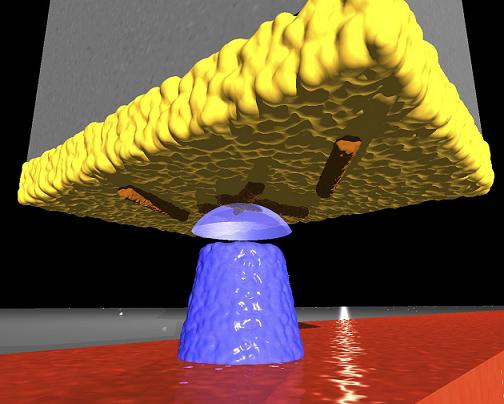The discovery is a significant step towards the development of new tools in the field of molecular biology and nanotechnology. The availability of such tools will make it possible to examine in depth complex three-dimensional structures, on a nanometric scale

Scientists at IBM's research laboratories, in collaboration with researchers from Stanford University, have presented a new MRI technology that enables magnetic resonance imaging with a resolution and resolution 100 million times higher than the existing MRI systems.
The results of the new research, published in the scientific journal Proceedings of the National Academy of Sciences (PNAS), constitute a significant step towards the development of new tools in the field of molecular biology and nanotechnology. The availability of such tools will make it possible to examine in depth complex three-dimensional structures, on a nanometric scale.
Such a high separation (resolution) technology allowed scientists to create a microscope that could - after further development - allow a glimpse into the details of the structure of proteins, and pave the way for personalized medical treatment and drugs targeted at the level of the individual protein structure of the treated patient.
The new development by IBM scientists may affect the world of materials research - from proteins to integrated circuits - where an understanding of structures at the level of the single atom is required.
The current progress was made possible with the help of Magnetic Resonance Microscopy (MRFM) technology, which detects extremely tiny magnetic forces. The imaging technology is able to examine structures that are deep below the surface of the material being examined and thus offers a clear advantage compared to the electron microscope known today. The testing process does not damage or destroy the tested material, which allows for an in-depth study of biological materials.
In the process of testing and developing the new technology, the IBM and Stanford University researchers tested a strain of a virus that damages tobacco crops), while going down to a separation level of four nanometers (a nanometer is one billionth of a meter). The size of the tested virus is 18 nanometers.
Unlike familiar MRI devices, which use a magnetic coil to launch and receive the magnetic resonance returning from the examined body, the unique microscope developed at IBM uses a tiny tip made of silver and designed as an extremely fine surfboard. When a magnetic response is received, the silver plate shakes with a tiny vibration - which is measured by an extremely sensitive laser that picks up the magnetic rotation around hydrogen atoms located near the silver tip. A XNUMXD scan of the tip allows the construction of a XNUMXD model of the surveyed material with the help of this tip, and vibrates it.

8 תגובות
But a microscope is more accurate than MRI as it has been around for quite some time, my eye is more accurate than some devices out there.
DA I'm sorry to spoil the party for you, but it's all about a lot of mumbo jumbo for a bit of converging calculation lenses and playing with the wavelength.... Duplicate me 10000 times and building such devices will not seem more complicated than connecting a stone to a stick.
The best site
Golan:
I'm not an expert on the matter. I'm just quoting from the article:
"The imaging technology is able to examine structures that are deep below the surface of the material being examined and thus offers a clear advantage compared to the electron microscope known today."
It is a combination of AFM with MRI which are the magnetic resonance combined with a scanning microscope. The scanning microscope only examines the surface and therefore cannot replace the MRI. Also, the resolution of MRI as you can understand from this article is 10 cm per pixel:
"A separation of four nanometers (a nanometer is one billionth of a meter)" + "which enables magnetic resonance imaging with a resolution and resolution 100 million times higher than the MRI systems that exist today"
This is not true. MRI makes separation on the order of microns (millionths of a meter).
I wonder where exactly the mistake fell in the translation between Hebrew and English. If it is indeed written that there is a hundred million times improvement over the resolution of today's MRI, then a resolution of between a pico and a femtometer is obtained, which is much smaller than a single hydrogen atom.
The article should be reexamined or explained more.
Greetings friends,
Ami Bachar
I'll admit that I haven't delved into the article yet, but does this technology allow (or will it allow) scanning of only the "surface" of the material? Or will you also allow a look inside into the internal structure of the material? If so, to what "depth"?
Thank you very much for the expert answers,
Thanks.
of technologies such as electron microscopy, and technologies for examining protein structure such as x-ray diffraction.
It will not replace the medical MRI.
This is a scanning magnet microscope.
Simply amazing, I just recently finished reading Ray Kurzweil's book "The Singularity is Near", Kurzweil emphasizes several times the issue of the level of resolution of an MRI scan that doubles from year to year in an exponential manner, something that he says will allow an accurate scan of the brain's structure to be carried out as a preliminary step to its reconstruction and copying into a silicon-based computerized structure, it's really beautiful to see how his predictions come true one by one, what an achievement for science, it will be really interesting to see where else it will lead us.
http://www.tapuz.co.il/BLOG/ViewEntry.asp?EntryId=1065939&passok=yes